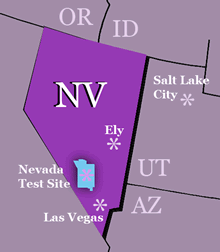 |
| In this Issue: | |||||||
HRSA Outreach Seeks to Raise Cancer Awareness Among People Who Lived Near Nuclear Sites and Mined Uranium
Besides downwinders, other eligible RESEP participants include nuclear test site employees who worked at the NTS, or at the Trinity (N.M.), Pacific, or South Atlantic test sites between 1945 and 1962. Miners, millers and transporters of uranium may also receive RESEP services and compensation from the Department of Justice if they worked in Arizona, Colorado, Idaho, Oregon, New Mexico, North Dakota, South Dakota, Texas, Utah, Washington or Wyoming between 1942 and 1971. Dr. Hunt said Nevada’s desert geography, which once made it attractive for nuclear testing, inhibits outreach to potential RESEP patients. Aging residents of isolated towns are reluctant to travel long distances on desolate highways to reach the Las Vegas RESEP clinic, which is part of the UNR School of Medicine. In the initial year of their RESEP grant, “only a handful of people came to our clinic in Las Vegas for cancer screenings,” Hunt said. “So by the second year, we hired an outreach coordinator and hit the road.” With a staff of five and clinical support from the University of Nevada medical school, the Nevada RESEP sets up shop for one day in family medicine clinics and HRSA-supported health centers and Critical Access Hospitals (CAHs), some as far as 450 miles from Las Vegas. In that day, the program usually screens about 50 people. Over the current fiscal year, the Nevada RESEP plans to visit seven or eight offsite clinics, with at least three physicians scheduled to participate at each. Since 2005, the Nevada RESEP has screened more than 673 people (as of April 30, 2008). Among those screened, more than 35 had “compensable” cancer covered by RECA. One community served by the program is Ely, a Nevada town of about 4,000 people 245 miles north of Las Vegas, where RESEP staff makes quarterly visits to a CAH to screen patients. Ely’s residents were particularly affected since prevailing winds often carried nuclear fallout from the NTS to them. “Nearly everyone in Ely remembers, or has heard stories about, dark red clouds and ashes falling from the sky,” Hunt said. “Spectators perched up in the mountains to see the blasts and children played outdoors with their parents watching them as the tests took place.” Hunt said several Ely residents have already been diagnosed with cancers of the small intestine, salivary gland, bladder, pancreas and liver, types of cancer the federal government says are “highly correlated” with radiation exposure. At HRSA’s Office of Rural Health Policy, Vanessa Hooker, RESEP project manager, said the new outreach effort seeks to locate people eligible for RESEP services, “no matter where they now live.” “The outreach encourages people who were exposed to radiation – or who have family members that were exposed – to visit HRSA's RESEP Web site,” explained Hooker. “There they can download an informational brochure, which is also available through the HRSA Information Center (1-888-ASK-HRSA).” Visitors to the Web site will find frequently asked questions, learn which jobs and locations make them eligible for cancer screening and other RESEP services, and be able to locate and contact the RESEP clinics that provide them. Those who cannot travel to a RESEP clinic are urged to talk to their physicians about their concerns, and get screened and treated if necessary.
|
|||||||
